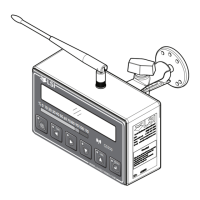52
52
The GS550 System
The GS550 System
5.4
5.4
Load Cells
Load Cells
5.4a Reading Accuracy
LSI
LSI flat bar load links are pre-calibrated at the
factory. No “zeroing” or other calibration is required
on installation. Each link is heat treated to age the
steel and ensure stable readings for many years; the
load cells are individually temperature compensated
to guarantee accuracy.
LSI
LSI flat bar load links are
calibrated to indicate between 100% and 104% of
their Safe Working Load (SWL).
LSI
LSI load pins, line riding tensiometers and
compression cells must be calibrated at installation
and every time thereafter the installation, the load
sensor or the transmitter is changed.
SAE J 159 4.2.1 recommends load indicating
devices should show not less than 100% of the
actual load and not more than 110% of the actual
load.
5.4b Load Testing
LSI
LSI recommends testing the load cell every year for
accuracy. The simplest way of testing a load cell is to
lift at least two known weights. A test weight should be
known with an accuracy of ±1%. If the load cell is
installed at the boom tip dead end, all additional
equipment such as blocks, slings, sensors, etc. should
also be known to an accuracy of ±1%.
Determine the accuracy of the tested system with
the following formula:
(Reference: SAE-J-159 7.3)
The test loads must be significantly relative to the
load cell capacity. The minimum test weight is
about 20% of the safe working load; a good test
weight is greater than 50% of the SWL. For
example, a 30 000 lb load cell on four parts of line
has a SWL of 120 000 lb; the minimum test load in
this case would be 24 000 lb, a good test load
would be 60 000 lb or more.
5.4c Care
Battery. Lithium batteries older than 18 months old
(alkaline batteries over 6 months old) should be
changed at the first available planned inspection
even if there is not yet a low battery warning. This
will avoid costly delays in the field.
Corrosion. Verify that no corrosion is visible on the
battery holder inside the load cell transmitter. If some
trace of corrosion is visible, rub it off gently and put
a small amount of dielectric grease* on each battery
holder post to protect the contacts.
Mechanical stresses. Verify the load cell sides for
dents or heavy scratches. The side of the load cell
under the transmitter box is the most sensitive
region. Engraving a number in this area will affect
load cell accuracy and reliability. If the transmitter
box has been hit and the box does not fit perfectly to
the underlying link, please call
LSI
LSI to have it
repaired. Engraving on the transmitter box sides will
not affect reading.
Seal. If the transmitter box has been removed it
must be correctly resealed with RTV non-corrosive
silicone.
Antenna. Small scratches on the antenna will not
affect radio communications. A heavy bending of the
antenna or bare sections on the wire may reduce
the radio efficiency.
Hex bolts. The hex head bolts on the transmitter
box are there to protect the antenna and to hold the
transmitter box on the load cell link. If one or both
hex nuts are scratched, it will not affect the load cell
readings or operation. If the bolt head is bent or
sheared verify that the transmitter box fits tightly to
the load cell link before contacting
LSI
LSI for
replacement bolts.
Indicated Load
Actual Load
X 100 = % of Load
* Dow Corning dielectric grease №4
WARNING!
Heavy shock may affect load
indication accuracy. Inspect the load cell
regularly for clearly visible dents or
scratches. Test the load indication if collision
damage is visible.
!
!

